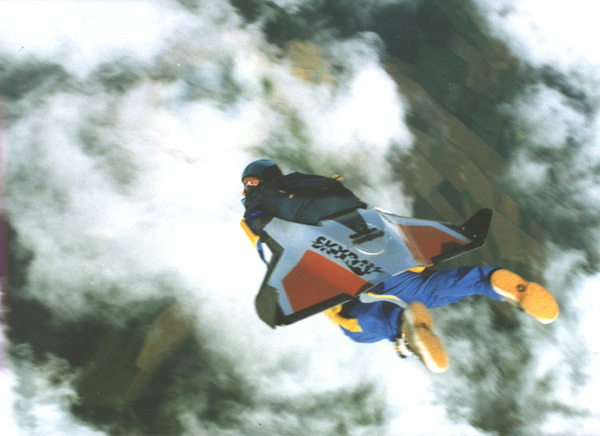Science Fiction
Dictionary
A B C D E F G H I J K L M N O P Q R S T U V W X Y Z
Skyray Human Glider Flight

Tired of dawdling along at one hundred and twenty miles an hour, a typical terminal velocity for human-shaped skydivers? Can you go faster? and farther?
Terminal velocity is the point where the force of air resistance pushing up on the skydiver is equal to gravity pulling down; the skydiver no longer accelerates, but falls at a nice constant speed no matter what you try. And of course, there's that whole "going straight down" problem.

For those who would like to go a little faster (not to mention farther) there's the Skyray, an attachable wing system that lets humans go beyond skydiving to "skyflying." In recent test flights, Skyray-equipped skyflyers have been able to attain speeds over 200 miles per hour. This is the same speed range as the fastest bird, the peregrine falcon, which stoops for prey at 200 miles per hour (not the spine-tailed swift, a comparative slowpoke at only 100 miles per hour, as reported elsewhere). Sir Hugh Beaver of Guinness Breweries spent a fortune to determine this fact, and launched the Guiness Book of World Records in the process.
Three long years of development in cooperation with the University of Applied Science (Munich) have created a two-piece device. The first section is a harness with rigid back section; the harness remains with the skyflyer after the second section, the wing itself, is released when the user is ready to parachute the rest of the way to the ground. The wing has its own parachute and is recovered separately. This configuration was designed for safety (by all means, safety first) and is patent-pending.
The best distance is reached with a glide ratio of two to three and a resultant velocity of about 220 kilometers per hour. Recently, a skyflyer flew across the English Channel in this manner, becoming the first non-powered flyer to do so. Carbon fiber and aramid fiber were used in construction for strength and lightness; the whole assembly weighs only nine pounds.
Science fiction fans of course remember personal powered fliers like the copter harness from Robert Heinlein's 1954 novel The Star Beast as well as the jump harness from the same author's 1961 novel Stranger in a Strange Land (see this link for more information about powered personal flight).
Reference articles and sources:
Airborne Humans (Skyray Airborne Humans)
Skyray at Freesky GmbH
Skyray in Flight (Skyflyer point of view) (takes a long while to load)
The physics of skydiving
Scroll down for more stories in the same category. (Story submitted 12/17/2003)
Follow this kind of news @Technovelgy.| Email | RSS | Blog It | Stumble | del.icio.us | Digg | Reddit |
Would
you like to contribute a story tip?
It's easy:
Get the URL of the story, and the related sf author, and add
it here.
Comment/Join discussion ( 5 )
Related News Stories - (" Vehicle ")
The 'Last Mile' In China Crowded With Delivery Robots
Yes, it's a delivery robot. On wheels.
Musk Idea Of Cars Talking To Each Other Predicted 70 Years Ago
'My cars talk to one another.' - Isaac Asimov, 1953.
Waymo And Tesla 'Autonomous Cabs' Are Piloted By Remote Drivers
‘Where to, sport?’ the starter at cab relay asked. - Philip K. Dick, 1957.
Maybe It's Too Soon To Require Autonomous Mode
'I hope all those other cars are on automatic,' he said anxiously. - Arthur C. Clarke, 1976.
Technovelgy (that's tech-novel-gee!) is devoted to the creative science inventions and ideas of sf authors. Look for the Invention Category that interests you, the Glossary, the Invention Timeline, or see what's New.
Science Fiction
Timeline
1600-1899
1900-1939
1940's 1950's
1960's 1970's
1980's 1990's
2000's 2010's
Current News
The Zapata Air Scooter Would Be Great In A Science Fiction Story
'Betty's slapdash style.'
Thermostabilized Wet Meat Product (NASA Prototype)
There are no orbiting Michelin stars. Yet.
Could Crystal Batteries Generate Power For Centuries?
'Power could be compressed thus into an inch-square cube of what looked like blue-white ice'
India Ponders Always-On Smartphone Location Tracking
'It is necessary... for your own protection.'
Amazon Will Send You Heinlein's Knockdown Cabin
'It's so light that you can set it up in five minutes by yourself...'
Is It Time To Forbid Human Driving?
'Heavy penalties... were to be applied to any one found driving manually-controlled machines.'
Replace The Smartphone With A Connected Edge Node For AI Inference
'Buy a Little Dingbat... electropen, wrist watch, pocketphone, pocket radio, billfold ... all in one.'
Artificial Skin For Robots Is Coming Right Along
'... an elastic, tinted material that had all the feel and appearance of human flesh and epidermis.'
Robot Guard Dog On Duty
I might also be thinking of K-9 from Doctor Who.
Wearable Artificial Fabric Muscles
'It is remarkable that the long leverages of their machines are in most cases actuated by a sort of sham musculature...'
BrainBridge Concept Transplant Of Human Head Proposed
'Briquet’s head seemed to think that to find and attach a new body to her head was as easy as to fit and sew a new dress.'
Google's Nano Banana Pro Presents Handwritten Math Solutions
'...copy was turned out in a charming and entirely feminine handwriting.'
Edible Meat-Like Fungus Like Barbara Hambly's Slunch?
'It was almost unheard of for slunch to spread that fast...'
Sunday Robotics 'Memo' Bot Has Unique Training Glove
'He then started hand movements of definite pattern...'
Woman Marries Computer, Vonnegut's Dream Comes True
'Men are made of protoplasm... Lasts forever.'
Natural Gait With Prosthetic Connected To Nervous System
'The leg was to function, in a way, as a servo-mechanism operated by Larry’s brain...'
